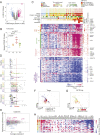Profound Treg perturbations correlate with COVID-19 severity
- PMID: 34433692
- PMCID: PMC8449354
- DOI: 10.1073/pnas.2111315118
Profound Treg perturbations correlate with COVID-19 severity
Abstract
The hallmark of severe COVID-19 is an uncontrolled inflammatory response, resulting from poorly understood immunological dysfunction. We hypothesized that perturbations in FoxP3+ T regulatory cells (Treg), key enforcers of immune homeostasis, contribute to COVID-19 pathology. Cytometric and transcriptomic profiling revealed a distinct Treg phenotype in severe COVID-19 patients, with an increase in Treg proportions and intracellular levels of the lineage-defining transcription factor FoxP3, correlating with poor outcomes. These Tregs showed a distinct transcriptional signature, with overexpression of several suppressive effectors, but also proinflammatory molecules like interleukin (IL)-32, and a striking similarity to tumor-infiltrating Tregs that suppress antitumor responses. Most marked during acute severe disease, these traits persisted somewhat in convalescent patients. A screen for candidate agents revealed that IL-6 and IL-18 may individually contribute different facets of these COVID-19-linked perturbations. These results suggest that Tregs may play nefarious roles in COVID-19, by suppressing antiviral T cell responses during the severe phase of the disease, and by a direct proinflammatory role.
Keywords: COVID-19; FoxP3; Tregs; tumor Tregs.
Copyright © 2021 the Author(s). Published by PNAS.
Conflict of interest statement
The authors declare no competing interest.
Figures





Update of
-
Profound Treg perturbations correlate with COVID-19 severity.bioRxiv [Preprint]. 2020 Dec 15:2020.12.11.416180. doi: 10.1101/2020.12.11.416180. bioRxiv. 2020. Update in: Proc Natl Acad Sci U S A. 2021 Sep 14;118(37):e2111315118. doi: 10.1073/pnas.2111315118. PMID: 33330871 Free PMC article. Updated. Preprint.
References
-
- Laing A. G., et al. ., A dynamic COVID-19 immune signature includes associations with poor prognosis. Nat. Med. 26, 1623–1635 (2020). - PubMed
Publication types
MeSH terms
Substances
Grants and funding
LinkOut - more resources
Full Text Sources
Medical
Molecular Biology Databases
Miscellaneous

